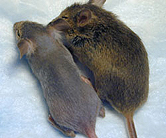
THURSDAY, Sept.1 (HealthDay News) —
Molecular signals from stem cells within the skin’s fatty layer trigger hair growth in mice, a finding that may lead to new treatments for baldness in people, researchers report.
“If we can get these fat cells in the skin to talk to the dormant stem cells at the base of the hair follicles, we might be able to get hair to grow again,” senior study author Valerie Horsley, an assistant professor of molecular, cellular and developmental biology at Yale University, said in a university news release.
Details of the discovery appear in the Sept. 2 issue of the journal Cell.
Stem cells are still present in the hair follicle roots of men with male pattern baldness, but the cells lose the ability to spur hair growth. It’s been known that these follicle stem cells require signals from within the skin to grow hair, but until now, the source of those signals was unknown.
When hair dies, there’s shrinkage of the layer of fat in the scalp that comprises most of the skin’s thickness. When hair growth begins, the fat layer expands, the Yale team explained.
They found that hair regeneration in mice requires a type of stem cell (adipose precursor cells) involved in the creation of new skin fat cells. They also found that these cells produce molecules (platelet-derived growth factors) that are necessary to produce hair growth.
Scientists are trying to determine whether the signals that promote hair growth in mice are the same needed to produce hair growth in humans.
The work was funded by the National Institutes of Health and the Connecticut Stem Cell Research Program.
More information
The American Academy of Family Physicians has more about hair loss.

